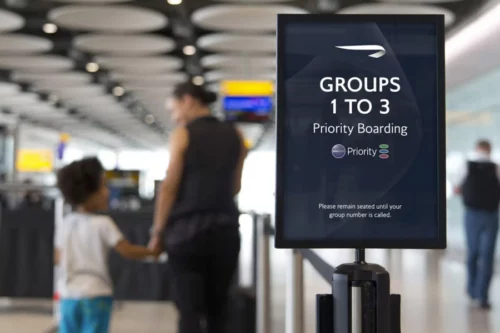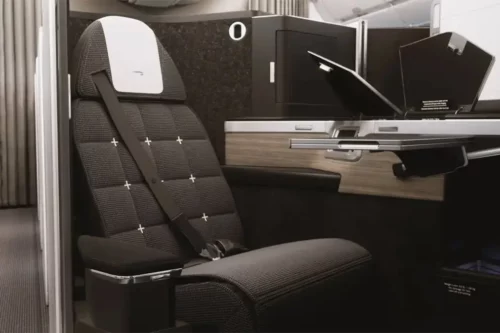British Airways changes its boarding groups
Links on Head for Points may support the site by paying a commission. See here for all partner links.
How does British Airways board its aircraft? Let’s take a look at the different boarding groups used.
First introduced in 2017, the British Airways boarding process involves ranking passengers based on status and cabin class.
Those with higher status or those travelling in premium classes board first; those with lower status or travelling in economy board later.

The idea was to avoid the scrum of people hovering around the gate and streamline the process to make it more relaxing for everyone involved. That doesn’t always work, of course; often there are not enough seats at the gate to accomodate all passengers, leading to overcrowding regardless. It does at least mean that BA’s higher-value passengers get priority.
Not sure what group you are? Your group number should be printed in big letters on your boarding pass.
British Airways has recently changed the boarding process
British Airways recently brought in some changes which are designed to speed up boarding in Economy.
It was decided that ten boarding groups was too many. Who could have guessed?!
Groups 7-9 have been removed from long haul boarding and groups 6-9 have been removed from short haul boarding.
Economy passengers will now be split into Groups 4, 5 and 6 on long haul and Groups 4 and 5 on short haul.
These are set by seat row. Group 4 comprises the REAR part of the Economy cabin and Group 5 (and Group 6 on long haul) comprise the front part.
The idea is that Group 4 passengers can immediately access their seats at the back of the aircraft without being blocked by passengers sitting in rows nearer the front.
How does British Airways boarding now work?
BA treats boarding groups for short haul and long haul groups differently, further adding to the confusion, so we thought it was worth taking a look at the process.
Things get even more confusing when you consider ‘pre-boarding’ for customers who need assistance or have very young children, effectively increasing the number of groups even further.

British Airways short haul boarding groups
Anyone in Groups 0 to 3 is considered to be in a ‘Priority Group’. Here is how British Airways arranges its boarding:
Pre-boarding
Families with children under two years old or in pushchairs are invited to board first. They should arrive 50 minutes before departure so that pushchairs can be stored in the hold.
Escorted passengers with mobility assistance will also be pre-boarded.
Priority Group 0
- British Airways Premier members (we explain how you get a Premier card in this article)
- BA Executive Club Gold Guest List members (explained in this article)
Priority Group 1
- Club Europe passengers (short-haul business class)
- BA Executive Club Gold members
- oneworld Emerald members
Priority Group 2
- BA Executive Club Silver members
- oneworld Sapphire members
Priority Group 3
- BA Executive Club Bronze members
- oneworld Ruby members
- AerClub Silver, Platinum and Concierge members
Group 4
- Euro Traveller (economy) passengers sitting in the rear of the cabin
Group 5
- Euro Traveller (economy) passengers sitting in the front of the cabin
A quick note on hand baggage and boarding groups
On full short-haul flights, British Airways may insist that anyone travelling in Group 4 or Group 5 hands over wheely cases at the gate to be placed in the hold. This has become increasingly common.

British Airways long haul boarding groups
Anyone in Groups 1 to 3 is considered to be in a ‘Priority Group’. Here is how British Airways arranges boarding:
Pre-boarding
Families with children under two years old or with pushchairs are invited to board first. They should arrive 50 minutes before departure so that pushchairs can be stored in the hold.
Escorted passengers with mobility assistance will also be pre-boarded.
Priority Group 0
- British Airways Premier members (we explain how you get a Premier card in this article)
- BA Executive Club Gold Guest List members (explained in this article)
Priority Group 1
- First passengers
- BA Executive Club Gold members
- oneworld Emerald members
Priority Group 2
- Club World (business class) passengers
- BA Executive Club Silver members
- oneworld Sapphire members
Priority Group 3
- World Traveller Plus (premium economy) passengers
- BA Executive Club Bronze members
- oneworld Ruby members
- AerClub Silver, Platinum and Concierge members
Groups 4 to 6
- World Traveller (economy) passengers
Groups 4 to 6 are arranged according to seat row. Group 4 is for passengers at the rear of the cabin whilst Group 6 is for those sitting in the first few rows.
Boarding with friends and family
If you’re travelling with your partner, friends or family, you may find that you all have different group numbers.
As per the BA website, you will be able to board together:
“It is possible that customers travelling together may receive different group numbers. In this case, please make your way to the gate where you will be able to board together.”
I often board in Group 1 with friends or family even though they have a lower group number on their boarding pass. Simply indicate to the gate staff that you are boarding together and it should be no problem.
Find out more
British Airways has a dedicated page on its website which explains the boarding process and which you can find here.









Comments (104)